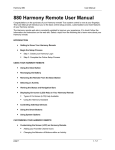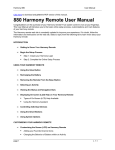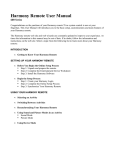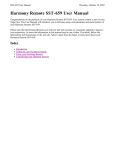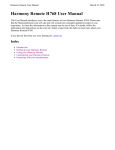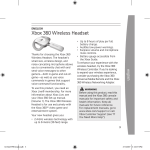Download 880 User Manual - Harmony Remote
Transcript
Harmony 1000 User Manual version1.2 User Manual Harmony 1000 Table of Contents INTRODUCTION........................................................................................................................................... 1 OVERVIEW OF THE HARMONY REMOTE ................................................................................................ 2 NAVIGATING THE MENUS ON THE REMOTE .................................................................................................... 3 RECHARGING THE BATTERY ......................................................................................................................... 3 DEVICES....................................................................................................................................................... 4 ADDING DEVICES TO YOUR ACCOUNT ........................................................................................................... 4 UPDATING DEVICES IN YOUR ACCOUNT ........................................................................................................ 4 UNDERSTANDING INPUTS ............................................................................................................................. 4 Overview of Inputs ................................................................................................................................. 4 Identifying the Inputs a Device Uses ..................................................................................................... 5 ACTIVITIES .................................................................................................................................................. 6 CREATING ACTIVITIES .................................................................................................................................. 6 SELECTING AN ACTIVITY ON THE REMOTE ..................................................................................................... 6 DISPLAYING HELP ON THE REMOTE ...................................................................................................... 7 TYPES OF HELP AVAILABLE .......................................................................................................................... 7 USING THE REMOTE ASSISTANT ................................................................................................................... 8 CUSTOMIZING YOUR HARMONY REMOTE ............................................................................................. 9 CUSTOMIZING THE DISPLAY ON THE HARMONY REMOTE ................................................................................ 9 Adding your Favorite Channel Icons...................................................................................................... 9 Changing the Behavior of Buttons Within an Activity ............................................................................ 9 Adding Custom-Labeled Buttons ......................................................................................................... 10 LEARNING INFRARED (IR) COMMANDS ........................................................................................................ 10 Using the Infrared Sensor .................................................................................................................... 10 Naming an Infrared Command ............................................................................................................ 11 USING THE REMOTE WITH THE RF WIRELESS EXTENDER ............................................................... 12 INSTALLING THE RF WIRELESS EXTENDER .................................................................................................. 13 ADDING THE RF WIRELESS EXTENDER TO THE Z-WAVE NETWORK .............................................................. 14 Assigning Devices to the Harmony Remote and the RF Wireless Extender....................................... 14 GETTING ADDITIONAL HELP .................................................................................................................. 15 FINDING ANSWERS TO YOUR QUESTIONS.................................................................................................... 15 v. 1.2 page i User Manual Harmony 1000 Introduction Congratulations on the purchase of your Harmony remote! This User Manual will provide you with information on the main features and customizations for your Harmony remote. If in doubt about how to set up your Harmony remote, follow the information and instructions using the Logitech Harmony Remote Software (also referred to as Harmony Remote Software). The Harmony remote is an Internet-powered universal remote control. Your Harmony remote can control most devices that understand infrared (IR) signals. The configuration of your Harmony remote is simple: • You will be prompted to answer questions about your entertainment devices to create your own personal Harmony remote configuration. For more information see Devices. • Your answers will provide us with a description of the entertainment devices you want to control, how they are set up, and your preferences for controlling them. • If one of your devices is not in the Harmony remote's database, the Harmony Remote Software will learn about your device and add it to your configuration. • Once you have told us about your devices, you will then be guided through setting up Activities. An Activity is a set of commands the Harmony remote sends to your entertainment system to turn on the necessary devices. Setting up Activities is simple: you will be prompted to indicate the devices you use within an Activity and how you want to control specific features, such as the volume, within that Activity. Once you have selected an Activity, you are in Activity mode, and the functionality of each button on your Harmony remote is automatically configured for that Activity. Additionally, the display buttons will give you access to other commands for that Activity, which cannot be set to the standard buttons. Example For the Watch Television Activity, the Harmony remote sends commands to your entertainment system to turn on the necessary devices so you can watch television. The remote will be automatically configured for the Activity based on the answers you selected during the online setup process for the Activity. For information see Activities. At the end of the setup process, you will have your own configuration loaded in your Harmony remote. Use your Harmony Remote Software to: • Customize any of your Harmony remote’s features. • Add more entertainment devices. • Add more Activities. v. 1.2 page 1 User Manual Harmony 1000 Overview of the Harmony Remote Many of the Harmony remote's buttons are standard remote buttons. However, there are buttons and other functions that may not be so familiar to you. The extra buttons and functions give you access to the special features of the Harmony remote. A. OFF: Turns all devices off with one button press. B. USB Connector (along the side of the remote): Connect one end of the USB cable to this connector and the other end to your computer so that you can download your configuration using the Harmony Remote Software. C. Help: Asks you simple questions so that your Harmony remote can fix problems you are having within an Activity. D. Infrared Learning Port (along bottom of remote): The Harmony remote uses this port to learn commands from your original remote. E. Activities: Press Activities to view a list of Activities you have added. Press the Activity button you want and the Harmony remote will set up your entertainment system accordingly. F. Smart Buttons: While there is a default setting for the buttons in most Activities, you can customize these buttons to send different commands. • While there is a default setting for the buttons in most Activities, you can customize these buttons to send different commands. See Changing the Behavior of Buttons Within an Activity. G. Display: Shows a list of your Activities and devices, help, infrared (IR) commands and any available listings. H. Previous Channel: Press to return to the previous channel. v. 1.2 page 2 User Manual Harmony 1000 Navigating the Menus on the Remote A. Home: The home screen of your Harmony remote, where you can access your list of Activities. B. Settings: Access and change remote settings such as the date and time, touch-screen, backlight, background, and volume, as well turn on/off the Remote Assistant, and view a tutorial on using the remote. C. Numeric Entry: Depending on the Activity, this icon will display a numeric or alpha-numeric keypad to change channels, CDs, and more. D. Transport: Play, Pause, Stop, Replay, Record are examples of some of the buttons that will be displayed or when you are in Activities such as Watch TV or Play a CD. E. Favorites: In the Watch TV Activity, this icon will list the favorite channels. To use this feature, you must use the remote control software to set up favorite channels. F. Custom Buttons: Find secondary Activity controls depending on the Activity, as well as add your own customized buttons. G. Disc Changer: Activities that involve multiple discs, such as CD or DVD players. The Watch DVD Activity will have a list of a discs (for a multi-disc DVD player), the Listen to Music Activity will have a list of CDs, etc. H. Game Controller: In Activities involving game controls, the Harmony remote can simulate the functionality of a game controller for popular gaming consoles allowing you to play DVDs and CDs. Recharging the Battery Place your remote in the base station to charge. While the remote’s battery is charging: • The display, its backlight, and the keypad backlight will remain on for a few seconds, and then turn off. • When the battery is low, the display will flash a message reminding you to charge the battery. Note: On occasion, you may notice that when you pick up the remote control it suddenly turns off devices that you had turned on. This can happen when your body picks up a static electric charge from your surroundings, like walking across a carpeted floor, and you then pick up the remote. Should this occur, you can simply restart the Activity you were in. v. 1.2 page 3 User Manual Harmony 1000 Devices A device refers to the individual components that make up your home entertainment system. Examples of devices TV, DVD player, digital set top box, Tivo® Adding Devices to Your Account Before you can add devices, you must install the software from the CD that was packaged with the remote, or from the Logitech web site. Once you have installed the software, you will be prompted to create a member account so that you can store your information about the devices in your home entertainment center. After you have created an account the software will guide through a step-by-step process that will ask you questions about the type of devices you have (manufacturer and model information), and how you want to use and control them. Updating Devices in Your Account After you have set up your Harmony remote, should you want to update any devices stored in your account—you're replacing an existing device with an upgraded model, or you have purchased a device for the first time—you can log in to your account, and edit your list of devices and settings. You will need to update the remote with your latest changes. Understanding Inputs This section provides a description of what inputs are, where they are commonly located, and some suggestions on how to tell what input a specific device uses. Overview of Inputs Home electronic devices such as televisions, DVD players, and stereo receivers require an audio and/or video signal to perform their intended purpose (playing sound or a DVD). The source of the signal can come from a cable company, an antenna, a satellite, a DVD player, etc. Typically, the signal is sent via a cable, or multiple cables that plug into your device. The connector that the cable plugs into is called an input. There are different types of inputs, and sometimes a single device can have more than one type of input. Examples RCA inputs Co-axial inputs Optical inputs An input is the connector on a device through which a signal (audio, video etc.) enters the device. An input can also refer to a signal sent to a device. v. 1.2 page 4 User Manual Harmony 1000 Identifying the Inputs a Device Uses To identify the names of the inputs for your device, try any of the following that apply to your device: • Using the Input, Source or Function button on the original remote for the device, switch through all of the inputs and note the name of the input that is displayed on the device. • Review the device's user manual, which should list all of the available inputs. • Look at the back of the device and make a note of the names and amount of inputs. v. 1.2 page 5 User Manual Harmony 1000 Activities An Activity refers to the common uses you have for your devices. For example, a common use for a TV is to watch TV shows; a common use for a DVD player is to watch movies. Harmony uses the term Activity to refer to a group of devices you use in order to watch TV, a movie, and many other uses. In this way, if you watch movies using your TV, DVD player, and a stereo receiver (for sound), you can create an Activity called Watch a DVD. The Activity will store information on the devices you need to watch a DVD—in this case, your TV, DVD player, and stereo receiver—and the specific settings for each device (e.g. TV must be set to the Video 1 input, the DVD player must be on, and the stereo receiver set to play sound for the DVD). Creating Activities To create Activities you must install the software from the CD that was packaged with the remote, or from the Logitech web site. Once you have installed the software, you will be prompted to create a member account so that you can store your information about the devices in your home entertainment center and the settings for each Activity you create. After you have created an account, the software will guide through a step-by-step process that will ask you questions about the type of devices you have (manufacturer and model information), and how you want to use and control them. Selecting an Activity on the Remote View the Activities you have added by pressing the Activities button. The display will then list the Activities you have added. Press the Activity you want to start. As a default, when you select an Activity, you will see a message on the remote’s display reminding you to keep the remote pointed at your entertainment system while the Activity starts. This helps ensure that all infrared (IR) signals are properly sent. v. 1.2 page 6 User Manual Harmony 1000 Displaying Help on the Remote From time to time when you select an Activity, the Activity may not work. This can happen when the Harmony remote sends many infrared commands to set up all your devices for an Activity, but one or more devices are not receiving some commands. The Harmony remote is then "out of sync" with your devices (e.g. it thinks one of your devices is on, but it is actually off). Some of the reasons the Harmony remote can become "out of sync" with your system are: • Someone walks between the Harmony remote and your entertainment system while an Activity is starting. • You point your Harmony remote away from your system while an Activity is starting. • There is an object blocking the line-of-sight between your Harmony remote and the system. • You are very far away from your entertainment system. You will need to use the Help button on your Harmony remote to resynchronize the remote with your devices. Before the remote tries to resynchronize with your devices, ensure the cause of the problem has been addressed. Example Remove all obstructions so that the entertainment devices can receive the infrared commands from the Harmony remote. Note: If your devices are no longer responding consistently to your Harmony remote, but were doing so before, you may need to recharge the battery. To resynchronize: 1. Press Help on the remote. 2. Answer the questions on the remote’s display by selecting Yes or No. If you answer no to any question, the Harmony remote will resend the necessary command and ask you the same question again. When you are done, the Harmony remote will be synchronized with your devices again. Types of Help Available You can customize the Help button on your Harmony remote to provide one of the following types of help: • Smart help Asks questions about the devices that are on during a specific Activity. • Full help Asks questions about all the devices in your system. Select Full help if you find devices aren’t being controlled the way you want them to and the help on the remote is not asking you questions about these devices. v. 1.2 page 7 User Manual Harmony 1000 Using the Remote Assistant Extra help is available from your remote by turning on the Remote Assistant. While the Help button helps you solve device problems within an Activity, the Remote Assistant teaches you how to use your Harmony remote. The following is an example of the type of help the Remote Assistant offers: Example If any devices are not set up correctly, press Help now. v. 1.2 page 8 User Manual Harmony 1000 Customizing Your Harmony Remote Use the Harmony Remote Software to: Troubleshoot • Click Troubleshoot to adjust settings in your configuration when your Harmony remote isn’t controlling your system correctly. Add, edit or delete Activities • Click Activities to add or delete Activities. • Click an Activity icon to change the specific settings (e.g. the name of an Activity) for an Activity. Add, edit or delete Devices • Click Devices to add or delete entertainment devices. • Click a device icon to change the specific settings for a device you have already set up. Change Remote Preferences • Click Remote Preferences to change the remote’s settings. Find Support Information • Click Support to view a list of support tools and contact information for our customer support center. Update the Remote • Update your remote after you have made changes to your configuration or settings. This will ensure you download your latest configuration and settings to your Harmony remote. Customizing the Display on the Harmony Remote This section provides information that will help you to customize the commands and options listed on the Harmony remote’s display. The resolution on the Harmony remote is 320 x 240 pixels. The Harmony remote comes with a set of defaults, which you can change to make the display look the way you want it to: • Select or add your own backgrounds for the display. • Add your icons for your favorite channels (you can upload your own icons up to a maximum of 160 KB (file size), and 24-bit .png, .bmp, .jpg, or .gif .) • Add your own slide show to the display. You can use the default backgrounds or your own background images to create your own slide show. The slide show displays while the remote is in the base station. Adding your Favorite Channel Icons Use the remote control software to customize the display for your Favorite Channels menu by adding your own icons and setting an icon for each of your Favorite Channels. Changing the Behavior of Buttons Within an Activity When you select an Activity, the Harmony remote will: • v. 1.2 Turn on all the correct entertainment devices page 9 User Manual • Set the device inputs correctly • Set up the remote’s buttons to control the Activity Harmony 1000 Based on our knowledge of how each of your devices is controlled, the Harmony remote will make its best effort to provide you with all the buttons you need to control an Activity. However, there may be some commands you want to add to buttons or access via the display. Commands can be added to buttons quickly and easily by customizing any Activity to change the behavior of buttons. The change behavior of buttons feature shows you the: • Buttons that have a command associated with them • Device being controlled • Command being sent to the device Adding Custom-Labeled Buttons You can also add any number of custom-labeled buttons to an Activity. Custom-labeled buttons are displayed on the Harmony remote’s display from left to right, top to bottom. Learning Infrared (IR) Commands The Harmony remote can learn infrared commands from other remote controls, and should only be used in situations where the Harmony infrared database does not already contain an infrared command you would like to use. Using the Infrared Sensor The Harmony remote has an infrared sensor along the bottom side. The Harmony remote uses this sensor to learn commands from original device remotes. • A: Your original remote • B: Distance between remotes: 5-10 cm (2"-5") apart • C: Your Harmony remote v. 1.2 page 10 User Manual Harmony 1000 The following steps outline what happens when you press a button on your original remote control: 1. The infrared sensor on the Harmony remote learns the infrared signal. 2. The Harmony remote uploads it via the USB cable (and your computer's internet connection) to the Harmony database. 3. The Harmony remote software will try to find a matching pattern for the infrared signal. 4. If no pattern is found, the signal will be stored as-is in its original format. 5. If a pattern is found, the Harmony remote software converts the signal into a format for convenient storage. Either way, the signal is then available for you to assign to a button on your Harmony remote. Naming an Infrared Command When you teach an infrared command to the Harmony remote, give the command a name. This way you can refer to this command by name in various locations of the online setup process. It is best to use the default names provided in the learn infrared commands step so that automatic button function assignments can be applied to your Harmony remote. Example If you teach the volume button infrared commands from your original remote control, name them "VolumeUp" and "VolumeDown" (i.e. with no space, and capitalization as shown). The Harmony Remote Software looks for commands with these names to automatically assign them to the volume up and down buttons on the Harmony remote. Naming Conventions When naming a command for which there is no default name in the Learn infrared commands step, use the following naming conventions to make button assignment and sharing infrared commands easier: • Do not use spaces or special characters such as /, & or * in the name. • Capitalize the start of words (e.g. NextDisc, ModeDigital). • Start the command name with its main function (e.g. VolumeRearUp, VolumeRearDown, VolumeFrontUp, VolumeFrontDown). This helps group related commands in lists. • For infrared commands that select inputs (e.g. on a stereo receiver), start with the prefix "Input". Do not name the input based on what you have connected to your device, rather name it based on what it is called on the front of the device, or on the remote control (e.g. InputAux, InputVideo1, InputTape, InputDVD, InputVCR). v. 1.2 page 11 User Manual Harmony 1000 Using the Remote with the RF Wireless Extender The Harmony RF Wireless Extender (sold separately) allows you to use the Harmony remote to control devices that are out of view (e.g. they are inside a cabinet). Note: Update the RF Wireless Extender each time you make any changes to the configuration of your remote. The RF Wireless Extender has four dual-head IR (infrared) emitters (one emitter can control two devices) that can be used to control up to eight devices that are out of extender's range. The lights on the RF Wireless Extender provide users with important information, such as: • Status (A) Indicates that the RF Wireless Extender is sending commands. • Power (B) Indicates that the RF Wireless Extender is powered either by AC or USB. • RF (C) Indicates that the RF Wireless Extender is receiving RF signals. v. 1.2 page 12 User Manual Harmony 1000 Installing the RF Wireless Extender The extender can be wall-mounted or installed inside the cabinet where your devices are located. Wall-Mounted Cabinet v. 1.2 page 13 User Manual Harmony 1000 Adding the RF Wireless Extender to the Z-Wave Network Any time you update the remote, you must add the RF Wireless Extender to your Z-Wave network again. To add the extender to your Z-Wave network: 1. Take your remote to the RF Wireless Extender you want to add. Make sure the extender is plugged into a power outlet. 2. Press Add on the remote when you see a message reminding you to add an RF Wireless Extender to your network. 3. Press Connect on the RF Wireless Extender. By pressing Connect you will add the extender to your Z-Wave network. Assigning Devices to the Harmony Remote and the RF Wireless Extender You can assign either the Harmony Remote or the RF Wireless Extender to control your devices. Controlling a Device With the RF Wireless Extender: If you have set the RF Wireless Extender to control a device, the remote will send RF (radio frequency) signals (see A) to the RF Extender, which will then convert the signals to IR and send the signals to the device. Controlling devices using the RF Extender means you can control the devices even if they are behind closed doors (e.g. a cabinet) or in a different room (see B and C). Controlling a Device With the Remote: If you have set the remote to control a device, the remote will use IR (infrared) signals to control the device. In order for the remote to control the device, there must be a direct line of sight between the signal sent by the remote and the device receiving the signal (see A). v. 1.2 page 14 User Manual Harmony 1000 Getting Additional Help The Harmony remote provides you with several features to assist you with: • Finding answers to your questions quickly and easily • Troubleshooting the setup and customization process Finding Answers to Your Questions The help you find answers to your questions quickly and easily, log in to the software and consult any of the following tools: Tool Description Search A support tool that enables you to do a keyword search. Frequently-Asked Questions (FAQs) A searchable list of customer questions, with answers provided by Harmony's support center. User Manual The User Manual provides an overview of features of your Harmony remote and provides general information about setting up and using the remote. More Help button Click this button for help specific to the step you are on. Troubleshoot A support tool that helps you identify the settings that need to be adjusted in your configuration when the Harmony remote is not controlling your system correctly. If you cannot find the answer to your question, or are unable to troubleshoot your problem, contact your Harmony Support Team. v. 1.2 page 15


















